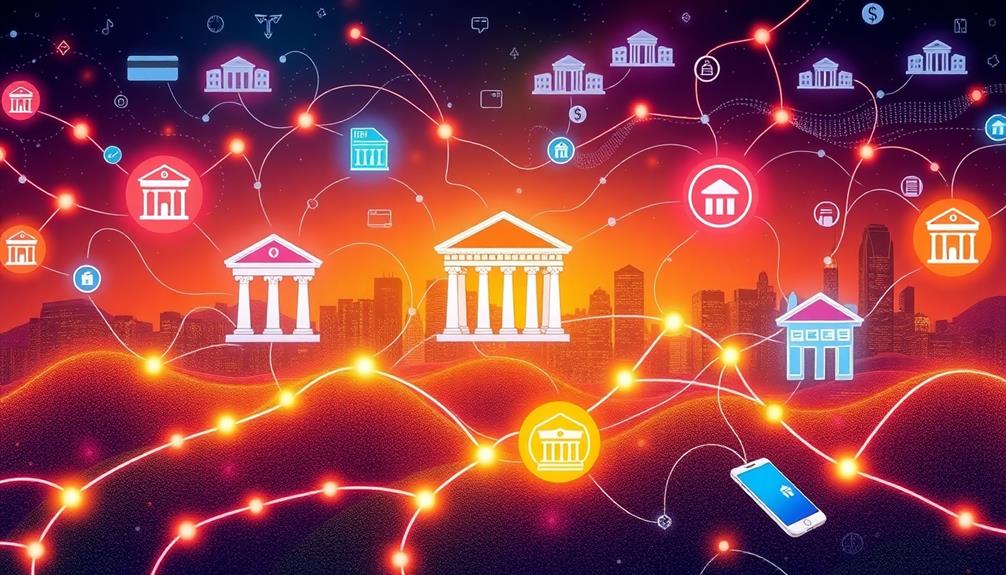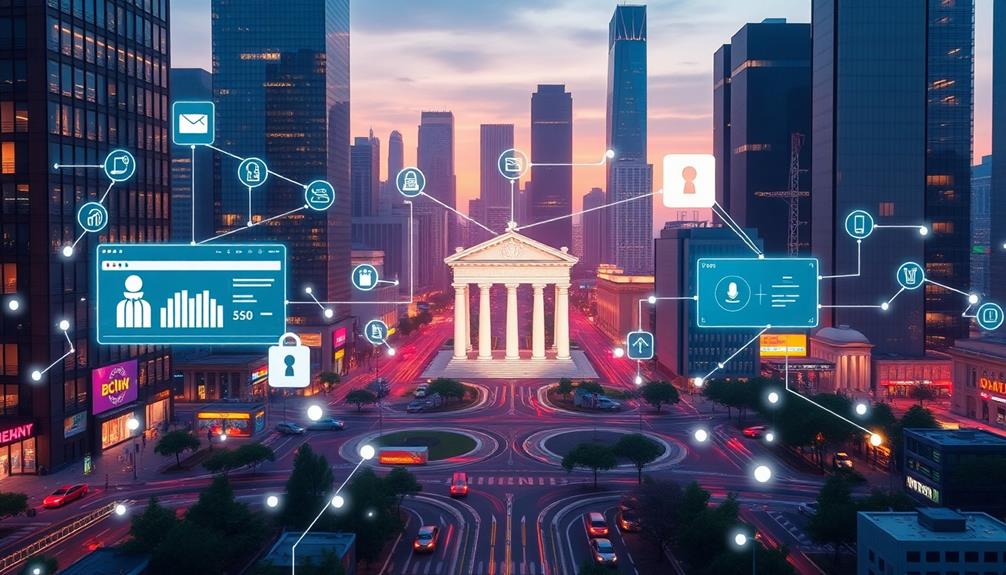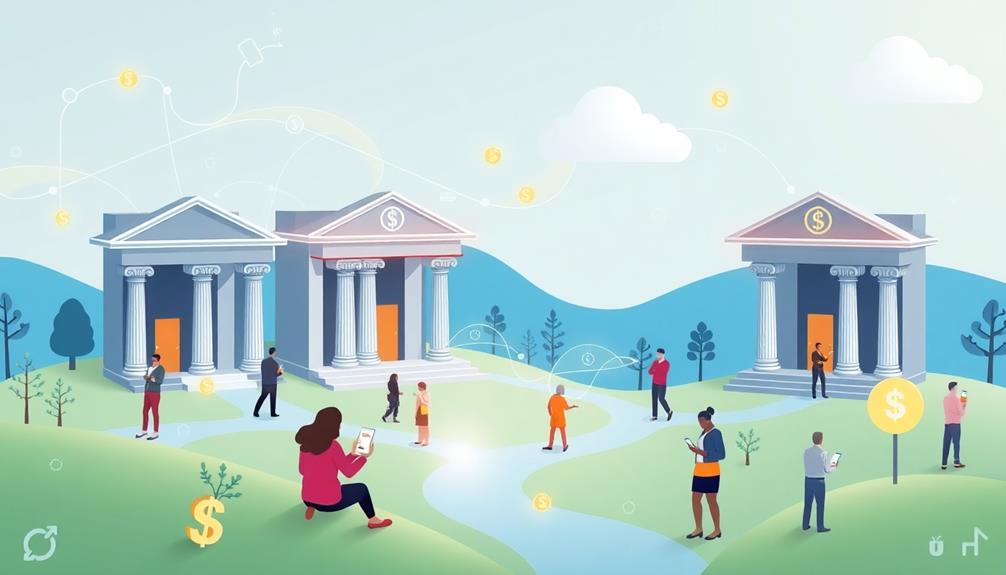Open Banking is revolutionizing payment services by allowing direct account-to-account transactions that cut out intermediaries. This leads to faster transactions, lower fees, and enhanced security. You'll enjoy real-time fraud detection and immediate transaction confirmations, improving your overall experience. As more businesses adopt these solutions, the volume of A2A payments is projected to exceed $200 billion by 2027. With robust regulatory frameworks encouraging innovation and competition, Open Banking offers financial solutions to a broader audience. If you're curious about the future possibilities and benefits, there's much more to explore on this topic.
Key Takeaways
- Open Banking facilitates direct account-to-account (A2A) payments, eliminating intermediaries and enhancing transaction speed and efficiency.
- The A2A payment model reduces transaction costs significantly by avoiding traditional interchange fees.
- Enhanced security features in Open Banking, such as real-time fraud detection, minimize risks associated with digital payments.
- Open Banking promotes financial inclusion by providing accessible payment solutions to underserved populations, improving their financial participation.
- The projected rise in API calls and A2A payment volume indicates a significant shift towards more innovative and competitive payment services.
Understanding Open Banking

In recent years, Open Banking has revolutionized how you interact with your finances. This financial model allows financial services providers to securely access your consumer data through APIs, fostering innovation and enhancing competition.
With Open Banking, you can manage your finances more effectively by using account aggregation tools that compile multiple bank accounts into a single dashboard, giving you better oversight of your financial management. Additionally, the integration of AI in business plays a significant role in personalizing financial services and improving customer experience.
Regulatory frameworks, like Europe's PSD2, require banks to share customer data with authorized third parties, driving the global adoption of Open Banking. This system not only reduces transaction costs but also promotes financial inclusion by offering alternative credit assessments for individuals who've thin or no credit histories. As a result, underserved populations gain access to financial services that were previously out of reach.
The rapid growth of Open Banking is evident, with over 100 billion API calls recorded in 2023 and projections estimating that number will soar to 580 billion by 2027. This expansion signals a significant shift in how you can take charge of your finances, empowering you to make informed decisions and enjoy a more streamlined banking experience.
Mechanics of Open Banking Payments

Open Banking Payments transform the way you make transactions by allowing direct transfers between bank accounts through secure APIs. This innovative approach utilizes the account-to-account (A2A) payment model, which eliminates the need for intermediaries, making your payments faster and more efficient.
As credit card debt continues to rise, the need for more efficient payment solutions becomes critical for financial health.
Here are some emotional benefits you might experience:
- Faster access to funds: Enjoy immediate transaction confirmation, enhancing your peace of mind.
- Lower transaction costs: Save money as fees are reduced, making your financial life easier.
- Enhanced security: Rest easy knowing that your consumer data is protected by rigorous security protocols.
With third-party providers leveraging these secure bank API connections, the entire payment experience becomes seamless. You can initiate real-time transactions, ensuring that both you and the recipient are informed as soon as the payment is processed.
As open banking continues to evolve, the volume of A2A payments is expected to exceed $200 billion by 2027. This growth reflects a significant shift in payment services, allowing you to engage with your finances in a more direct and efficient manner.
Benefits of Open Banking Payments

Transforming the way you handle transactions, Open Banking Payments offer numerous benefits that enhance your financial experience. By enabling direct transfers between bank accounts, these payment services facilitate faster transactions, greatly reducing processing times compared to traditional methods.
Additionally, the efficiency of these payments can greatly impact your budgeting and finance management, allowing for better tracking of expenses through regular monitoring and adjustment of your payment methods. You'll notice lower transaction costs too, as Open Banking eliminates intermediaries, avoiding the interchange fees often associated with credit and debit card transactions.
Security is another key advantage. With enhanced measures like real-time fraud detection, both you and merchants can enjoy secure transactions, minimizing the risk of fraud and chargebacks. The account-to-account (A2A) payment model ensures a seamless user experience, providing immediate transaction confirmations that boost customer satisfaction.
Moreover, Open Banking Payments promote greater financial inclusion. They make innovative payment solutions accessible to underserved populations, allowing everyone to participate more fully in the financial ecosystem.
Implementation of Open Banking Solutions

As you explore the advantages of Open Banking Payments, understanding how to implement these solutions effectively becomes vital to maximizing their benefits.
Aeropay offers a user-friendly onboarding process that requires no technical expertise, making it easy for you to access financial products and services. By leveraging their customizable bank-linking technology, you can enhance scalability in payment processing and guarantee a seamless connection between your bank accounts.
Additionally, implementing robust fraud detection measures is essential to safeguard your transactions and maintain customer trust, which aligns with identifying and managing risks.
Here are a few reasons why implementing open banking solutions is vital:
- Enhanced Security: APIs that allow for the secure transfer of consumer data protect your customers and your business.
- Tailored Integrations: Customized demos help you understand how to implement open banking to fit your specific business needs.
- Reduced Fraud: Industry-leading approval rates mean you're more likely to see successful transactions.
Future Trends in Open Banking Payments

The landscape of open banking payments is rapidly evolving, driven by advancements in technology and changing consumer preferences. As you navigate this space, you'll notice a significant increase in open banking API calls, projected to jump from over 100 billion in 2023 to 580 billion by 2027. This surge reflects a growing trend in data sharing and payment services, much like the importance of selecting the right cold medication for effective relief in healthcare.
Account-to-account (A2A) payments are set to capture 10% of the digital payments market by 2027, directly challenging the current dominance of credit card transactions. The U.S. A2A payment volume could exceed $200 billion, with a 19% growth rate, indicating strong consumer adoption.
Regulatory developments, like the CFPB's proposed Personal Financial Data Rights rule, will enhance competition and innovation, offering you more choices in payment services.
Additionally, the integration of artificial intelligence in open banking is expected to boost transaction efficiency and streamline payment processes. This means you'll likely experience more personalized financial offerings as providers leverage your financial data to tailor their services to your needs.
Embracing these trends will be essential for both consumers and businesses alike.
Frequently Asked Questions
How Does Open Banking Work for Payments?
Open banking for payments lets you securely log into your bank, authorize transfers directly from your account, and enjoy instant confirmations. It streamlines transactions, reduces costs, and enhances security without relying on traditional payment intermediaries.
What Are the Effects of Open Banking?
Open banking greatly enhances your financial interactions. You'll experience quicker payments, lower costs, and access to innovative services. It empowers you to manage finances better, making transactions smoother and fostering competition in the financial sector.
Are Open Banking Payments Faster Payments?
When it comes to speed, you're in luck! Open Banking payments are indeed faster. They cut out the middlemen, allowing direct transfers between accounts, which means your money moves quicker and you get instant confirmations.
What Are the Downsides of Open Banking?
You might find several downsides to open banking, like potential data privacy issues, security vulnerabilities, and confusing terms. Smaller institutions could struggle, leading to fewer choices and possibly higher costs for your banking services.
Conclusion
In today's fast-paced world, open banking's like a bustling marketplace, where vendors and customers seamlessly connect, exchanging ideas and services. You've probably noticed how quickly payments are processed now—it's like magic! With its potential to streamline transactions and enhance security, open banking isn't just a trend; it's shaping the future of finance. As you navigate this evolving landscape, consider how these innovations can simplify your financial interactions, making every transaction feel like a breeze.









